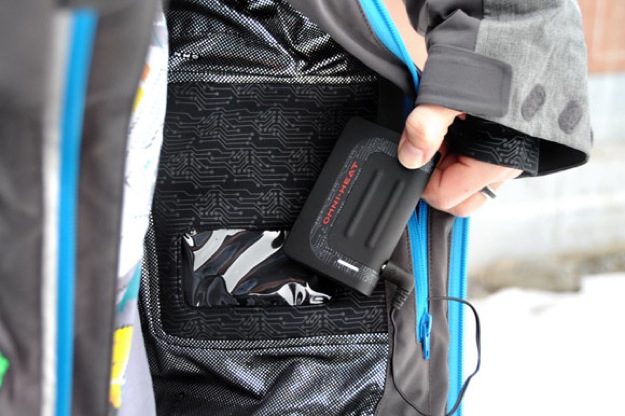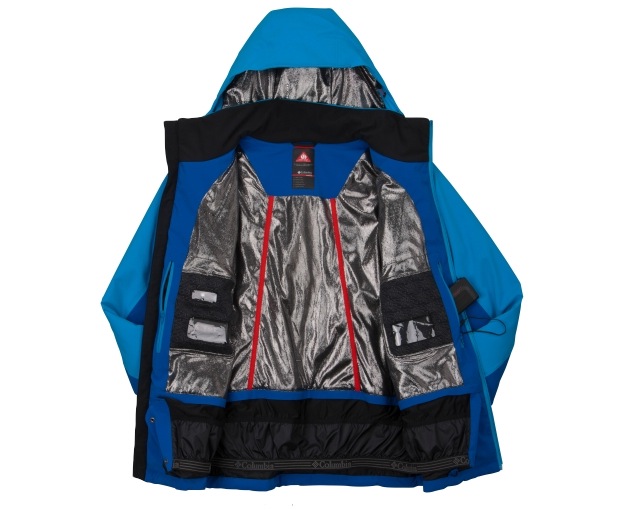
There are a few battery-powered electric jackets on the market today, but none quite like this one. Most come with a bulky heating pad-like insert and run off of heavy D-cell batteries that are less-than-innovative. When popular sportswear brand Columbia (well-loved here in Oregon for its hometown status) decided to take its electric heating technology (which has been in boots for a few years already) to jackets, they brought in experts to create the perfect Columbia-specific battery and built the jackets from the ground up. The result is a truly innovative take on how to stay warm during the winter months, whether you’re on the sideline at a football game or hitting the slopes on the mountain.
We got a chance to get some hands-on experience with the Columbia Omni-Heat Thermal Electric Circuit Breaker Softshell ($850, available for men and women), which is one of five electric jacket designs for men and three for women. We got a full walk-through of the technology with Columbia representatives and wore the jacket out and about for several weeks so we could bring you our thoughts on what you need to know about the design, specs, and functionality. Before we get into our own thoughts, however, we will explain the basics of just how this technology works.
The Technology
From the outside, the Circuit Breaker Softshell looks like any other high-end winter jacket. The jacket is made from a waterproof, breathable stretch softshell material that is fully seam-sealed and the insulated jacket features waterproof zippers, a removable and adjustable storm hood, underarm venting, a drawcord-adjustable hem, three outer pockets, and an inner security pocket. To start off the heating technology, the interior of the jacket is lined with silver thermal reflective Omni-Heat fabric that uses tiny dots to reflect your own body heat (and the electric heat) back at your body. The interior of the jacket features two pockets (one on either side at waist level) that hold the components of the electric heating.

There is a very small “brain” that helps the batteries trade off heating duty, as well as two lithium-ion polymer batteries that are about the size of a rectangular flip phone. The batteries, which are rechargeable via the accompanying AC adapter or any USB port, are thicker than an iPhone but a little bit smaller in size. These batteries are the power source for the heat in the jacket, but they do not actually heat up at all. The heated part of the jacket is actually flexible carbon fiber circuitry that is integrated into the fabric of the jacket. When you do turn the batteries of the jacket on, that flexible circuitry provides comfortable heat across the lower half of the back of the jacket as well as at the wrists.

One of the benefits of the flexible circuitry is that once the batteries are removed from the jacket, it can be washed and worn like any normal jacket without any hassle or concern. The power of the jacket is controlled by an easy-to-use, waterproof controller button on the right-side-chest of the outside of the jacket. Press the button for three seconds and the button will glow red, indicating that it is now on the highest heating level. Press the button again and once more to cycle through to yellow (medium) and green (low) settings. While the glowing light will definitely tell others that you are wearing a jacket with extra cool factor, if you’d rather blend in you can hold the button for 10 seconds to go into “Stealth Mode” where the light will fade off.
How well does it work?
In our own hands-on experience, we found that the Omni-Heat Electric jacket performed impressively on all fronts. Sure, there are a few things that we might like to change or improve on, but overall the jacket kept us warm and comfortable, even in cold temperatures and winds. There’s a little more to it than that, so we’ll explain exactly what we liked and didn’t like about our experience with Columbia’s Omni-Heat Electric.
Right off the bat we could tell that the jacket was a well-made high-quality softshell with or without the electric technology. While we’re betting that the flexible carbon fiber circuitry is mostly responsible for the $850 price tag, Columbia didn’t skimp on the rest of the details either. Everything about the jacket feels durable and sturdy, from the waterproof zippers to the general exterior fabrication. We mostly liked the feel of the jacket once we put it on as well. The jacket is made a bit heavier by the batteries and though we think Columbia put them in the right place (at the waist), the cellphone-shaped batteries are definitely noticeable. We found that we got used to the small amount of added bulk pretty quickly and the general form-fitting shape is flattering and comfortable.

Perhaps the best thing about the Omni-Heat Electric technology is that it is extremely easy to use once you’ve got the batteries in place. Press the button and within minutes (maybe two) you will feel the comfortable warmth on your back and at the wrists of the jacket. You’ll want to change the setting based on what kind of temperatures you are in (and how long you want the battery to last), but even the lowest setting gave us a nice amount of heat on a chilly 34-degree day with some wind.
On any of the settings, the heat is noticeable and pleasant but not overwhelming. The technology is designed to be less like a heater and more to comfortably maintain your body temperature when you’re in not-so-comfortable cold temperatures. We found that description to be very accurate. When we wore the jacket in the coldest environment (at the top of a viewpoint on a 34-degree day with large winds, see above photo), we wouldn’t say that we were toasty and warm with the jacket on, but our body temperature stayed comfortable instead of dipping into shivering territory like it might have otherwise (I’m cold-blooded, what can I say?).
We thought the battery life was respectable and definitely lived up to what Columbia had told us prior to testing. We found that switching between settings the jacket gave us an average battery life of about four hours. According to Columbia, the high setting will last for up to three hours, the medium up to four, and the low up to six hours. If you are only using the battery intermittently, maybe while skiing you only use it while resting or on the chair lift, then you might get a full day’s worth of heat. This is one area that we can see being improved upon, but it’s still long enough to be adequate for almost any day’s activities.
The most complicated part of using the jacket is probably charging the batteries, although we thought it was pretty painless. Users can simply remove both battery units from their respective pockets and plug both of them in (via a micro USB to USB cord that plugs into the AC adapter) to the wall adapter to recharge. The charge time is about six hours, so we’d recommending charging them overnight. Once the batteries are recharged, users must make sure to slide them back into the jacket’s battery pockets in the right position so that a small cord (connecting the two batteries) can plug into each battery. Once turned on, there is an indicator light on each battery that will show percentages of 25, 50, 75, and 100-percent charge. If you forget one of the batteries at home, fret not; the jacket will still function just the same, only with half as much battery life.
Conclusion
While we do have a few nitpicks on the jacket, we would say that overall we were very impressed with the Columbia Omni-Heat Thermal Electric Circuit Breaker Softshell. It performs well as a regular jacket, is stylish and comfortable, and of course offers innovative electric heat technology that will keep you cozy and happy at almost any temperature above 0 degrees. The technology is easy to use and the battery lasts long enough to be suitable for almost any day-long activity if you only need intermittent heat. We found all of the heat settings to be comfortable, and with active lifestyles in mind, we particularly like that there are three different settings so skiers, snowboarders, or other athletes don’t overheat if they just need a little extra core warmth.
The biggest drawbacks, which are to be expected from such technology, are the battery size, battery life, and the rather hefty price tag. We think all of these things could be improved on if Columbia wants to see these jackets make it big for people other than the most serious winter sport fanatics, but we’re not surprised or disappointed by such drawbacks. Integrating such technology into a great jacket (and doing it well) is expensive, and battery size and life are things that we will always want to improve.
Let’s just say this — looking ahead to the winter months spent outside or on the mountain for ski season, standing in the cold or getting stuck on the chair lift doesn’t sound nearly so bad now that we have the Columbia Omni-Heat Thermal Electric Circuit Breaker Softshell and its little glowing button on our side.
Check out the brand’s Bugaglove Max Electric gloves ($399), which incorporate the same electric technology to keep your hands just as warm as your body, to complete your winter ski or snowboard ensemble.
Second image via Engadget


